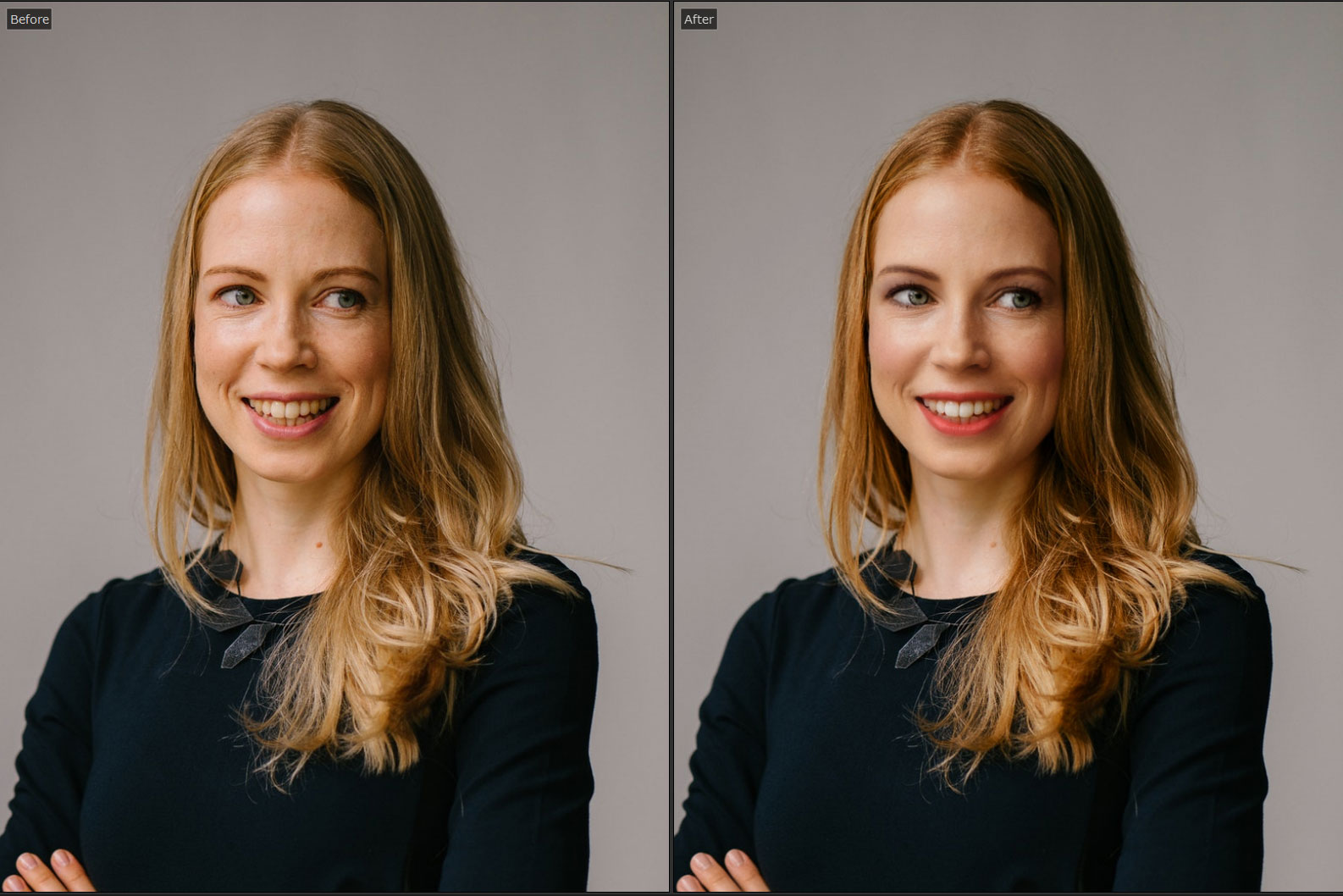Awesome Tool for Fast, Quality Retouching
Review by Jessica Maldonado
Professional retouching in Photoshop requires years of experience and hours of meticulous work, but it’s rare we have the luxury to devote that time to every portrait. I’ve enjoyed reviewing PortraitPro in the past, so I jumped at the chance to test the newest version of the software, PortraitPro 17, which is available in three versions: Standard, Studio, and Studio Max. This review is for the PortraitPro 17 Studio Max version, which is the only version with a batch mode.
Whether you're a casual smartphone shooter or a professional using an SLR, software can get the most out of your images. We help you find the best photo editing software for your needs. I detected a software called Portrait Pro 18 from Anthropics and after a test I thought that it could be usefull and improve my workflow with portraits - sometimes the retouching in LR is very time consuming. Obviously it should only be used to make light changes to portraits.
PortraitPro 17 can be used as a standalone app, and the Studio and Studio Max versions can be used as a plug-in for Photoshop, Lightroom, Aperture, or Photoshop Elements. I recommend using it as a standalone for quick batch processing and its ability to save your session as a project if you’re called away from your computer.
The PortraitPro 17 software instantly detects faces in each image opened. Results are quick and usually very good, but it’s easy to adjust the guide nodes if they’re off the mark. The standard retouching that PortraitPro automatically serves up is good, so you could potentially have a retouched image ready to go in just one minute. Closed eyes or extreme facial expressions can trip it up, so look out for this on batch-processed work.
I don’t love that Face Sculpt and lighting adjustments are part of these standard results. As I’ve critiqued in the past, a scrupulous retoucher begins with the face as-is, only correcting as necessary for perceived flaws. Photographers choose their lighting carefully, so it’s off-putting to me that these are added automatically. It’s no problem, however, as it’s just one click to turn off any adjustment section.
Photo Studio Pro Reviews
There’s a tab full of Preset menus (Global, Face Sculpt, Skin Smoothing, etc.) that you can easily fine-tune with the sliders (back under the Controls tab). Batch processes only allow you to choose from the Global presets, but a fast workaround is simply to save anything you’d like as “Global” (I did this for no-sculpt-skin-smoothing-only batches to address my issues).
The best new addition to this version of PortraitPro is the ability to save Snapshots as you work, so you can experiment with different looks and revert back to the original version quickly if you don’t like them.
The Face Sculpt controls really are pretty cool, and do have their place in some portrait retouches, for example: Fix uneven eyes or lips—at the modest end—or slim and elongate for clients who desire it. Restraint and small movements will give pleasing results; pushing things too far will, of course, look cartoonish. Now that Photoshop has Face-Aware Liquify, these abilities are less unique, but for non-Photoshop users, definitely desirable.
Skin Smoothing is the superstar section of PortraitPro 17’s controls. Restrain yourself here, and you’ll never have plastic/over-blurred skin again. However, the Spot Removal sensitivity menu in the Skin Smoothing controls still doesn’t appear to do anything, and the Touch Up brush doesn’t work as well as I’d remembered (growing pains?).
The Skin Lighting control section requires restraint to avoid strange artifacts around your subject, but it’s handy for adding back some of the dimension that can be lost from skin smoothing (especially around the cheekbones and sides of the nose). Makeup settings are useful and fun, but the presets aren’t great—I’d love Anthropics to team up with a cosmetics company for real-world looks. Eye and Mouth & Nose controls give you sliders for the left and right eye and the top and bottom lip, respectively. Here, you can brighten, sharpen, and whiten eyes and teeth, and adjust eye and lip color. Changing hair color is notoriously difficult to accomplish believably, even with Photoshop, and the Hair controls still yield artificial-looking results. Low settings here can improve the shine or vibrancy of the hair, but that’s about it. The Picture controls allow for overall exposure adjustments and the like. And a nice addition, new to this version, are Vignette controls.
Background editing is the “big” new feature in this update, but it’s not ready for prime time. I was hopeful when the initial masks popped up (not bad!), but the refinement tools are clunky to use and don’t mask hair well—so critical to portrait composites. It’s less intuitive to use than other sections; for example, you can’t use the Spacebar to move around the image. Also, you must choose and finalize your new background while in PortraitPro 17, if you’re running it as a plug-in, since no mask or alpha channel are returned to Photoshop. PortraitPro Project sessions do retain the ability to change the mask and background. For someone with no access to Photoshop, this might be worth a try. Currently, it’s unnecessary bloat to an otherwise great application.
Pro Portrait Tele G4 Review
Despite my critiques on some features, PortraitPro 17 Studio Max is still the best option I’ve tried for quickly editing multiple portraits with good results. It’s fun to use, and gives tons of control for a reasonable price. Check out the website for online and upgrade discounts, as Anthropics was offering all three editions at 50% off at the time of this writing. ■
While many of us would rather outsource image retouching, it’s an exchange of creative control for greater time efficiency. PortraitPro 18 is an alternative, which is what initially drew me to Anthropic’s PortraitPro Studio Max several years ago when I reviewed version 15. Complete control: check. Improved efficiency: check. The original images shown in this review are straight from the camera, and retouches have been made solely with PortraitPro.

The PortraitPro 18 Studio Max installer prompts you regarding plugins for Adobe Photoshop and Lightroom. For easy access to PortraitPro from those programs, install the plugins. Once installation is complete, you can open PortraitPro directly or via Photoshop (Filter > Anthropics > PortraitPro…). In Lightroom you must set up an additional external editor (Edit > Preferences > External Editing) by navigating to the PortraitPro application file. Then you can right-click any image and access PortraitPro (Edit in > Edit in PortraitPro…).
© Betsy FinnTo see the extent of PortraitPro 18 editing potential, compare the original image (top left) to the one with a background added (top right), makeup added (bottom left), and facial sculpting (bottom right), which is best left for instances where the client requests it.
Upon opening an image, PortraitPro automatically detects faces and attempts to determine age and gender (adult male, adult female, child), but you can override mistakes. On the right side of the screen is a menu toolbar full of sliders and selections—skin lightening, skin masks, eyes, makeup—you name it, PortraitPro pretty much has it covered. There’s even a retouching brush you can use to paint over blemishes that escaped the first round of auto retouching and a restore brush that can remove retouching. Version 18 also allows you to completely mask all edits in an area.
While PortraitPro is good for editing individual images, where it really shines is in batch mode. You can select a folder of images (I use the Windows dialog menu to search for just the TIF files I’ve created in a given folder), and PortraitPro will grind away at recognizing facial features and applying retouching presets to each one. At this point, the extent of PortraitPro’s efficiency is up to you. Either close out the auto batch immediately or tweak individual images as desired.
PortraitPro takes retouching to the next level, or maybe even beyond. The default retouching preset is too heavy-handed for my style, particularly with facial sculpting. Fortunately, there’s an easy fix: custom presets. I created my own preset with a natural, authentic look that matches my own style.
Compared to its predecessor, PortraitPro 18 has faster and more accurate facial recognition (with more draggable points), an improved restore brush, better background masking, options for layers such as a logo or other overlay on top of the image, and more. There are also improvements to hair, skin, and eye controls, including an “open/closed” eyes feature.
My favorite upgrade is the ability to enable non-destructive editing with smart filters in Photoshop (Filter > Convert for Smart Filters). When you run PortraitPro and return to Photoshop, a Smart Filter layer is created that you can toggle off or use to tweak later edits. This is a big improvement over the last version I tested, which required starting from scratch in PortraitPro if you wanted to change your retouching after running the Photoshop plugin.
© Betsy FinnPortrait Pro Body Review
PortraitPro 18 works extremely well for smoothing skin tone and opening eyes just a bit wider. Compare the original capture (top photo) to the edited version (bottom photo).
I’ll preface my conclusion by saying that I don’t expect anyone to use all the features in this software for everyday retouching. But, should you ever need it, it’s nice to know that PortraitPro has covered all the bases as far as makeup, hair, skin, and backgrounds.
Is there anything PortraitPro can’t do? I encountered one situation where my subject was in profile view with her eyes closed. While the “eyes closed” buttons worked nicely in other situations, I didn’t see an option for “eyes off” in that specific situation.
Beyond that, I have a couple things I’d love to see in future versions: the ability to run a batch edit from a selection of Lightroom images, the ability to export PortraitPro’s background mask to Photoshop, and flexibility in the TIFF file extension. Why the last one? It’s more of a workaround for the lack of batch editing from Lightroom. I’ve been exporting TIF files from Lightroom, batch editing them in PortraitPro, and then renaming the generated TIFF files to TIF so that Lightroom recognizes the edited files. TIF and TIFF are, practically speaking, the same extension. Adobe generates TIF files, PortraitPro uses the newer convention TIFF files.
Overall, PortraitPro is a delight to use, even though my retouching style doesn’t warrant taking full advantage of all its retouching features. If you’re looking to improve your retouching workflow efficiency but don’t want to outsource or worry about losing creative control, give batch mode a shot. It may be a game changer for you.
PortraitPro comes in three versions: Standard ($44.95), Studio ($69.95), and Studio Max ($139.95). The Standard version is limited to JPG and 24-bit TIFF files, lacks batch editing, and does not integrate with editing software. The Studio version lets you work with raw or 48-bit files and has a basic batch dialog. Studio Max has full batch mode for the greatest efficiency. Both Studio and Studio Max integrate with Photoshop, Lightroom, and Aperture. A free trial is available at portraitprofessional.com.
Betsy Finn is a portrait artist in Dexter, Michigan.
Tags: post captureretouchingtechniquePortraitpro
Related
Quick TakesOn Cloud Nine
Portrait Pro Body Review
For Lan Nguyen, daydreaming pays off.
